Text
Economic Worldbuilding: Capitalism
So you've created an intergalactic society, with droids and spaceships and sweet zero-g space battles. But wait, how do spaceships get to people who want to use them? Your world needs an economic system to tie it all together.
Read more
1 note
·
View note
Text
Building a Better Death Star (by not building a Death Star)
We've established that the Empire can technically afford to build a Death Star but that there are much cheaper options available to them, and everyone else with medium-sized, lightspeed enabled ships.
Does ramming planets with ships fulfill Vader's ultimate goals, however? Or is there a better option?
Read more
0 notes
Text
The Death Star is Bad, Actually (Part II)
66 million years ago, a big ol' hunk of rock slammed into the Earth and really messed the place up. Between 10 and 151 km in diameter, this asteroid went from the cruising altitude of a 747 to the ground in .3 seconds, killing all vegetation within thousands of kilometers immediately. Dinosaurs hadn't invented seismographs at that point, but if they had, it would've registered as an 11 magnitude earthquake (on a scale that stops at 10).
This asteroid, sadly, killed most of the dinosaurs. And yet, when it hit the Earth, it was probably going only 20 km per second.
The speed of light is 300,000 km per second. Most physicists consider this to be quite fast.
Read more
0 notes
Text
THE DEATH STAR IS BAD, ACTUALLY
In 2012, a petition to the US government to build its own Death Star garnered 30,000 signatures, enough to require an official response. According to Lehigh University, a Death Star’s materialswould cost some $850 quadrillion (2019 US GDP: $21.4 trillion) and require 13,000 times the amount of mineable resources on the planet Earth. At current rates of steel production, it would take 833,000 years to make a Death Star.
Read More
1 note
·
View note
Text
Where to get shot?
A discussion of bullet wound survivability, a la Socrates and Plato, for some reason.
Mod E: If you had to get shot somewhere, where is the best place to get shot? In terms of not dying?
Mod N: I'd prefer not to get shot.
Mod E: Yeah, but if you had to.
Mod N: Toe.
Mod E: I don't count a grazing. If I had to get grazed, I'd probably take arm or something, but in this case, you get properly shot.
Mod N: Toe.
Mod E: You want to blow the toe clean off?
Mod N: Toe.
Mod E: I'm getting a pretty consistent message here. Torso, neck, and head are out in terms of survivability. There's no way to guarantee survival in those cases.
Mod N: There's no way to guarantee survival if you get shot.
Mod E: I feel like if I get shot through the hand and I don't get some sort of pan-resistant antimicrobial infection, I'm pretty good, at least in the frontcountry, in modern times.
Mod N: Your hand is not so good.
Mod E: No, that's why I don't want to do hand or foot.
Mod N: Toe.
Mod E: I like my toes. I feel like maybe lower leg or forearm.
Mod N: Then you lose the hand/foot and part of the limb.
Mod E: There are a lot less bones to reconstruct in my forearm than my hand. I googled a hand reconstruction from a bullet wound and there's like a dozen surgeries to go through, if you get to keep the hand at all.
Mod N: Toe.
Mod E: But then you wouldn't have a toe.
Mod N: I've helped toe amputees ski before; you get used to it.
Mod E: How about I get shot in the right side of the chest instead of the left? As we all know, right-side chest injuries are harmless.
Mod N: I keep some of my lungs in the right side of my chest.
Mod E: Exactly, only some of them. So it sounds like you are going to shoot your toe off (not sure how that happened in the firefight) and I'm going to get a harmless right chest injury.
Mod N: Toe.
Mod E: Glad we're on the same page.
6 notes
·
View notes
Text
When can you remove a tourniquet?
Question: My medic applied a tourniquet to A's leg during evacuation to stop a bleed. When can the medic take it off?
Short answer: never!
How do Tourniquets Work?
Anyone can put a tourniquet on. There's no special cert you need—if you see someone bleeding a lot, you can attempt to stop it with a tourniquet. Taking a tourniquet off requires, far as I can tell, a medical degree. I don't believe even paramedics can take them off.
For those unaware, a tourniquet is a band, bandage, or other object wrapped around a limb to prevent bleeding. The idea is that if the tourniquet is really tight, it will compress all the arteries in that limb so your patient stops losing all of their blood (volume shock, anyone?). Patients keeping their blood is one of the single most important tenets of medicine.
Once applied, stuff besides blood starts to build up on the other side of the tourniquet, stuff like lymph, and potentially toxins. When the tourniquet is removed, all that toxic stuff rushes in to the previously isolated limb and can kill the patient.
Another, perhaps more obvious, result of removing a tourniquet is that your patient bleeds to death. Both bleeding to death and "tourniquet shock syndrome" are contraindicated in first aid.
Removing a Tourniquet
Best practice says A's tourniquet is staying on until A is at a hospital. Ideally, your medic has written somewhere on the tourniquet or skin when it was applied so doctors are aware.
If no hospital is in A's future, your medic's best bet is to remove the tourniquet sooner rather than later, before all those bacteria and yucky infectious things can build up. Keep in mind, this risks blood loss and death, so it's a bit of a balancing act.
Anyone who needs a tourniquet applies in a first-aid setting is in rough shape. Here's to hoping character A pulls through (or doesn't, if you want them dead).
13 notes
·
View notes
Text
Wilderness Protocol: Clearing a Spine
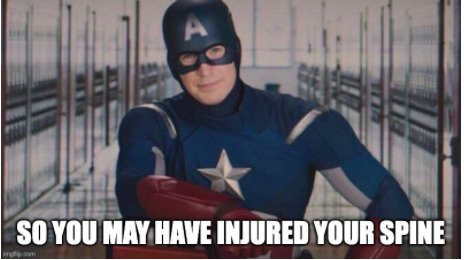
The worst has happened: your character's caretaker has uttered those fateful words. "What if his spine is injured?"
As we all know, even the possibility of a spine injury means we can no longer touch the injured person at all, let alone move him out of that running river. No, spines trump all. We leave him where he is until we can invent the technology necessary to teleport him out.
Or, you could show off your wilderness knowhow and have the caretaker clear his spine.
Read more
1 note
·
View note
Text
new organs coming out soon
medium intestine
gallkidneys
inferior vena cava
table of contents
semi-colon
die-r (opposite of liver)
pancreas 2
163K notes
·
View notes
Text
Fantasy Cartography: Mountains
Nary a day goes by without a question in r/worldbuilding about how to design a geologically accurate fantasy map. Therefore, without further ado, I present to you: why mountains form and where.
Why do mountains form?
Mountains form when there is too much rock in one place in the crust for the crust to be flat.
Where do mountains form?
Fantastic question. Mountains require a melt or a convergent plate boundary to form (unless you count igneous intrusions as mountains, which I will not for the purpose of this guide). So, any place with a melt or convergent plate boundary could have a mountain on it.
Let's start with melts. Melts are just a way to refer to rock that is a liquid. You might have heard it called lava or magma, but of course, lava is above the ground and magma is below the ground, so geologists kind of screwed themselves over by not making a generic way to refer to both. So, they came up with melt. (Since it's melted rock, get it?).
There are three ways to get a melt from the mantle to the crust, where it can start making mountains.
Decompression Melting
Decompression melting occurs at a divergent plate boundary, that is, a boundary where two plates are moving away from each other. In the mantle and crust, the liquid/solid state of rock is determined by the temperature and pressure regime. If we want to change the state, we need to change either T or P, and when the earth is pulling apart from itself, it decreases pressure, which causes rock to become liquid.
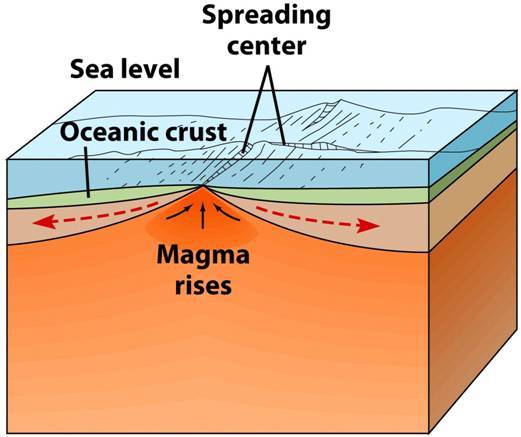
Source
The less dense liquid rock floats to the surface. However, decompresison melting doesn't tend to form mountains on land because the plates are pulling apart from one another. You're more likely to see rift valleys in these areas. Underwater, seafloor spreading can make vast mountain ranges.

Dark blue / purple are ridges. Fun fact: making maps like this is called bathymetry. Source.
Hey, Mod E, why'd you include it then?
Because there are three ways to form a melt and I didn't want to only give you two. Sorry. Anyway, the next two types will help you form mountains. Promise.
Subduction Melting
A subducting plate boundary is a unique type of convergent plate boundary where an oceanic plate meets a continental one. Ocean crust, being heavier, sinks beneath the continental crust, bringing water with it.

Source
When water interacts with the crust, it changes the composition and, by extension, its melting temperature. Suddenly, rock melts at a lower temperature.
This water-infused melt is buoyant (spelled that right first try, fear me) and rises. At the surface, it forms mountains and volcanoes. So, a great place to have mountains is where oceanic crust meets continental crust.
Here's an example:

The San Gabriels in Southern California were formed by a subducting oceanic plate. Source.
Hot Spots
Hot spots are parts of the mantle that, for some reason, are really hot. Unless something has changed recently, geologists do not know why they form. Perhaps the most famous hot spot is the one underneath the Yellowstone Supervolcano, but hotspots also do helpful things like: form Hawaii.

Hot spots are so hot that islands, volcanoes, and mountains can form above them. The trick with hot spots is that they don't move on a human timescale. Instead, the continents move above them.
Imagine a candle flame beneath a piece of paper. As you move the paper over the flame, its location changes. This is how you get the Hawaiian island chains instead of one really tall Hawaiian island.
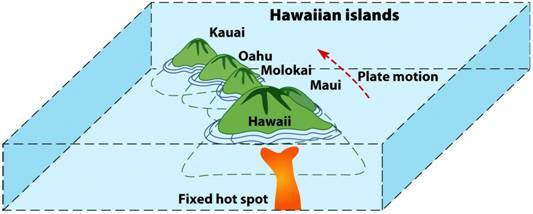
As the plate moves, the hot spot builds different islands. Source.
Hotspots are an excellent way to put mountains wherever you want. Either your readers accept that we don't know where and why hot spots form and therefore your mountain range is technically possible or they are so annoyed at your map, they dedicate themselves to a study of geology and create a unifying theory of hot spot formation in order to prove you wrong, which is a win for humanity (plus, you have at least one incredibly dedicated fan, so it's a win for you too).
Keep in mind, given the movement of hot spots, you probably aren't going to get mountain chains in squares, or smiley faces, or exes. They'll still be lines.
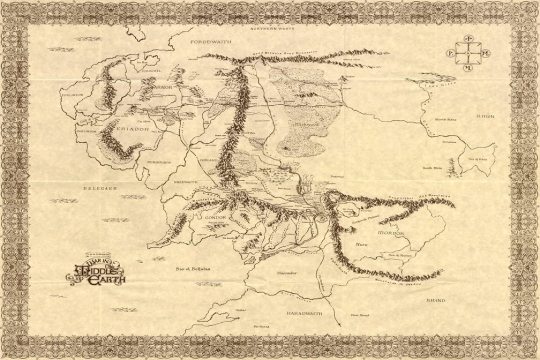
Tolkein may have defined the genre, but he did not define proper mountain placement. What is this? How are the mountains in a box like that? (In Tolkein's defense, he wrote The Lord of the Rings before the theory of plate tectonics was widely accepted.)
Convergent Plate Boundaries
The easiest place to put mountains, however, is at a convergent plate boundary, where continent meets continent. When this happens, there is simply too much rock to fit in one spot and it has to go somewhere. Down is full, so it goes up, making mountains and plateaus. The tallest mountains on Earth formed this way, as did the Tibetan plateau.

K2, the second-tallest mountain in the world but by far the coolest, is in the Karakoram range, not the Himalayas, but it formed from a convergent plate boundary. That K in K2 actually comes from Karakoram. Source.
Summary
Where can you put mountains?
Convergent plate boundaries, either oceanic-continental or continental-continental
Above hot spots (aka, wherever you want)
How not to place mountains:
At random, just one in each spot (mountains tend to form together)
In weird shapes (unless you hve a world building reason for it)
Happy mountain making!
2 notes
·
View notes
Text
Brand Treatment and Surving a Beatdown with Spine Intact
Question: I have a character who gets beat up by a group of people and branded on her cheek. I'd like there to be very little risk of spine injury and for another character to be able to treat her semi-effectively. There is healing magic in the world and it is entirely stat based, not experience based. Thoughts?
We'll focus on the two parts of this questions separately. First, how can you beat someone without risking spine injury? And second, how should you DIY a brand treatment? (Also, and hopefully this goes without saying, but you should not DIY a brand treatment IRL).
Spine Safe Beatdown
It is impossible to guarantee 100% that your injured character (IC) has no spine injury. That said, it's possible to reduce the risk.
Why do spines break?
Like any bone, spines can break. Unlike any random bone, vertebrae have a spinal cord inside them, and the shards of a broken spinal bone can sever the spinal cord, causing numbness, tingling, and paralysis. Spinal column injuries refer to broken bones only. Spinal cord injuries refer to a damaged cord, which almost always comes with at least one broken vertebra too (sort of a two for one injury deal).
Spines are finicky beasts, but they especially dislike the following types of force:
Compression up and down the spine (think like an accordion)
Twisty motions (like cracking your back, but worse)
Bending side to side (t-posing and then swaying from side to side)
Rough head jostling
Assymetric force from the front or back, which could cause the spine to twist
(For more fun breaking bones, see: Can Your Character Survive... Broken Bones?).
Protecting the Spine
So... basically any impact on the head or torso has the possibility to make the spine unhappy. Mod N suggests two equally strong goons punch both shoulders simultaneously and with the same amount of force. Since it's unlikely any goons are feeling that considerate, you can reduce the likelihood of a spine injury if you:
Have your character sitting on a chair with a back or lying down as opposed to standing during their beating. This gives the spine less room to get up to any funny business
Avoid too many blows to the head and neck. In movies, beatings seem to always involve grabbing the poor victim by the hair and then laying them out with a punch. This seems like a great way to get permanent spine and/or brain damage (Hey, Can Your Character Surive... Altered Mental Status, anyone?)
Avoid grabbing and pulling on the body by the head (I haven't been in too many beatdowns myself so I'm not sure if this is a frequent occurance)
Avoid any direct blows to the spine, avoid compression down the spine, avoid too much twisty spine motions
Ruling out Spinal Injuries
While it's best practice to assume spine injury in any trauma case until definitively proven otherwise, there are ways to semi-rule out any serious spine injury before you move someone, including:
Clearing the spine (the caretaking character doesn't appear to have medical experience, so this seems unlikely, but perhaps they could cast Heal Spine before further treatment)
Check if IC reports any unusual numbness or tingling
Check the spine itself for any obvious bruising, bleeding, tenderness, etc.
Ask IC if their spine feels okay (spinal cord injured patients often report that they know something is very wrong even if they don't know what)
If the caretaker has no way to care for a spine injury, it might be enough for them to simply think about the possibility. Or, if they don't have any medical experience at all, they might just jump to treating the more obvious injuries, in this case, the brand.
DIY Brand Treatment
My first thought when I hear about a cheek brand is, yikes and my second is, why doesn't that brand go through the cheek? That said, it appears cheek brands actually did happen historically (drawn images but no pictures of branding in the link).
Appearance
Brands are a type of third degree burn, which means the third layer of skin is affected, as well as the first two (no pictures in the link). The tool used to make the brand will affect the appearance.
Here's a video of someone getting a brand with a precision implement. (This is a dead dove, don't eat situation. Apparently, human branding is a squick of mine. I'm learning so much writing up this response!). In this video, because the hot tool is so tiny, the wound itself mostly looks red and swollen, with a few black lines where the actual brand occured.
I'm assuming when you say brand, you mean something like this:

Brand, from here,
Here's a healing progression—one week, one month, and three months—of a more applicable brand (pictures right at the top of the page after following the link). And here's what NOLS has to say about it: "The skin appears leathery, charred, pearl gray, and dry, or possibly white and firm. The area is sunken and has a burned odor." (I mostly just like "pearl gray" as a color name).
In that case, I think a blackened and charred shape of the brand, surrounded by perhaps a thin layer of white but mostly red and swollen skin is your best bet.
Reaction
Counterintuitively, the branded skin itself might not hurt because the brand has burned away all the nerve endings. I think it's safe to say the area around the brand probably hurts like hell (on account of this area is probably second- and first-degree burns).
There's also the added psychological complication of this brand being on the face, where humans are more psychologically vulnerable to injury. IC is probably not too happy right now, and it will likely be obvious her whole life that someone branded her there, though the shape itself may become obscured by scar tissue.
Here's the summary of a meta-analysis that looked at rates of anxiety and depression in people with visible differences (including facial scarring). It might be a worthwhile read, as might the study itself. Changing Faces is a charity dedicated to helping people with facial injuries.
Brand Concerns
What are we worried about when it comes to branding?
Airway: this is a face brand. Traumatic injuries on the face and neck could potentially interfere with IC's ability to breathe. Needless to say, that would be bad
Infection: skin is in charge of keeping foreign contaminants out of the body. If the skin is burned through, bacteria and viruses have a much easier time getting to the blood
Volume shock: a big enough brand can kill someone outright, though perhaps then it's less accurate to describe it as a brand and more accurate to say someone was burnt to death
Hypothermia: skin also keeps the cold out. In non-balmy environments, even small burns can put you at a high risk for hypothermia
Psychological trauma: for what I hope are obvious reasons
Cheeks aren't big enough for me to be too worried about volume shock or hypothermia, though your caretaker should monitor IC for signs of shock or uncontrollable shivering.
Brand Treatment
The first step with any burn is putting the fire out. Mod N likes to remind me that EMT training says you need to wash out any burn with cold water for 5 to 10 minutes, just in case it is still smoldering. Ideally, this is done with clean water, not ice cold. Do not put ice on the brand!
Next, to prevent infection, clean the wound of any outside debris (dirt, clothes, etc.) and apply some sort of antibacterial salve. If no salve is available, hopefully your caretaker has a Spell of No Bacteria up their sleeves.
Now to dress the wound. If it's relatively small (less than 3 palms of surface area), use a wet to dry dressing. That is, put wet gauze directly on the surface of the wound. Then dry gauze or a dry bandage as the next layer up. Change it once a day for cleaning. If your world has showers, don't put the wound directly under a shower head for at least a week.
Cleaning in this case means both washing the wound and cutting away dead skin. This is usually a dreadful experience for all involved. I have only treated moulaged wounds with a fake victim who screamed far too convincingly and it was miserable.
Inhalation Burns
Observative readers will note I mentioned airway concerns but didn't addressed them. Gold star for that reader. The caretaker should monitor IC's airway as standard practice but they also need to think about inhalation burns, which are burns to the inside of the mouth, throat, and lungs. These are always considered life threatening.
Inhalation burns are caused by breathing in hot materials, such as smoke. In the cosemetic branding video I recommended above, the brander himself wore a gas mask, presumably at least in part to keep from breathing in hot air. With the brand so close to IC's mouth and nose, inhalation burns are a distinct possibility.
Inhalation burns are treated in the wilderness with a swift evacuation. Your caretaker's best bet is going to be to either rule out inhalation burns or treat them magically. Depending on technology levels, a hospital or doctor may be able to help IC too.
Conclusion
IC is going through a bit of a rough patch, between the beatdown and the brand, but it's completely possible for them not to have any life-threatening injuries, especially if the goons avoid their spine during the assault and their brand is small and doesn't involve inhalation burns.
4 notes
·
View notes
Text
The Reckoners as a Metaphor for OCD
Spoilers for all three books in Sanderson’s Reckoners series, which, if you haven’t read, is excellent, and you should read.
The Reckoners trilogy takes place in a world where certain people, called Epics, have superpowers that corrupt those who wield them, making them more prone to mass murder than the average person. Power sets always come with a weakness, which the protagonist discovers is a fear, something the Epic was scared of before they gained their abilities. Most Epics avoid this fear. But, by confronting it, Epics can learn to use their powers without turning evil.
Where’s the metaphor for OCD? Well, if you know anything about OCD treatment via ERP therapy (and who doesn’t?), then the analogy is hopefully clear. If you don’t, allow me to spell it out.
What’s OCD?
Contrary to popular belief, OCD has nothing to do with cleanliness or perfection. OCD is a disorder categorized by:
Intrusive thoughts (obsession)
Strong, negative reactions to that thought
Compulsions to reduce the negative reaction (compulsion)
Oh hey, you see where the name OCD (obsessive compulsive disorder) comes from now?

Source
In the classic OCD stereotype, that might look like this:
My intrusive thought tells me the surface I touched is not clean.
I become absolutely terrified of the possibility that I am infected with salmonella and will die.
I wash my hands to convince my brain that I don’t have salmonella and won’t die.
At first, this might seem clever. Hey, you were scared, but then you took a concrete action and it made you not scared anymore! That’s great! And if the compulsion remained just a simple hand-washing, maybe it would be. Unfortunately, over time, OCD convinces you that one hand wash isn’t enough. Now it takes two to kill salmonella. Or three.
OCD obsessions and compulsions can be about absolutely anything, Here are some examples:
I saw a bat; therefore I have rabies.
I am anxious because I’m going to die of rabies.
I spent 8 hours online researching whether the bat outside gave me rabies before I am convinced that I won’t die.
What if I accidentally cheated on my boyfriend last night?
I am terrified I might’ve cheated on my boyfriend.
I ask my boyfriend every morning whether or not I cheated on him and he reassures me that I did not.
If I pick up a knife, I’ll accidentally kill my wife.
I an scared because I don’t want to kill my wife.
I refuse to touch knives, even butter knives.
That last example is called an avoidance compulsion, which is sometimes hard to spot because it’s the lack of a compulsion, though it is still detrimental. The Epics in the Reckoners series all follow the avoidance compulsion, refusing to ever interact with their fears.
OCD Treatment
I think there are two easy ways to misconceive of OCD and get the whole treatment wrong. The first is to assume intrusive thoughts are the problem and to try to get rid of them. This is what a lot of folks (myself included) assumed OCD treatment would look like. However, everyone, neurotypical folks included, has intrusive thoughts all the time. They just don’t react to them.
Another common response is to mitigate the compulsions. If you wash your hands too much, let’s get you some soap that’s softer on your hands. If it’s important for things to be clean, let’s help you clean the house twice daily. If you are worried you didn’t lock the door, take a picture so you can check later (as an aside, please don’t recommend this to people with OCD; this is called enabling a compulsion and reinforces the idea that if the door is unlocked, that’s a problem worth having a panic attack over, which it is not).
Both solutions will fail because neither addresses the actual problem, which occurs in step two. The problem is the anxiety response, not the intrusive thought and not the compulsion. It is possible to think any thought at all and not react to it.
Addressing Anxiety
Whether or not the intrusive thought is valid, the response is detrimental (if it wasn’t detrimental, you wouldn’t fit the diagnostic criteria for OCD). Treatment focuses on reducing the anxiety response by proving to your brain that the thought itself cannot hurt you. This is done through exposure response prevention therapy (ERP).
Basically, the brain is a complicated machine-learning algorithm. Every time it sees a compulsion relieve anxiety, it reinforces the idea that the compulsion is the only way to relieve anxiety. During ERP, you expose yourself to something you fear and refuse to engage in compulsions. Because the adrenaline response cannot last indefinitely, you eventually start feeling less afraid. Suddenly, your brain sees that there’s another way to get rid of the anxiety (I.e., by sitting with it). Over time, you can convince your brain that thoughts in and of themselves don’t require a reaction at all.
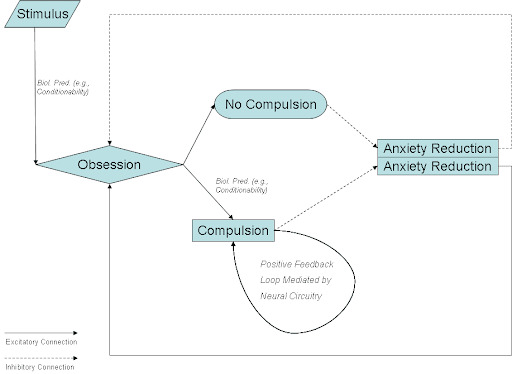
Source
I thought this was a post about the Reckoners
Only vaguely. I mostly wanted to talk about OCD (shh, don’t tell anyone). But, hopefully you can see some similarities now.
I see water.
I am terrified of water because it makes my powers go away and renders me weak.
I avoid water.
The Epics are all caught in a classic avoidance-based OCD obsession-compulsion loop.
But wait, I hear you cry. The Epics actually lose their powers when exposed to their weakness. Their reaction is justified.
Justified, maybe. Helpful? No. Most intrusive thoughts have a bit of truth in them. Bats can give you rabies. Rabies has as close to a 100% mortality rate as makes no odds. If you genuinely think you have rabies, you need to get a shot. Panicking about seeing a bat, however, does not help you survive rabies or make a rational decision about whether to get a rabies shot. The panic is useless.
Some OCD thoughts are completely true: in my case, I obsessed about my impending mortality. Unless I become the first immortal human (still working on that), my intrusive thought is accurate and I will die. Worrying about that now, though, is completely useless.
Similarly, the emotional reaction is interfering with the Epic’s life in a serious way. They could avoid their weakness just as well if they weren’t terrified of it. Again, the intrusive thought and compulsion aren’t what’s maladaptive here. It’s the emotional reaction.
And, when Epics face their fears head on, just as someone with OCD does during ERP therapy, the fear fades. In their case, it’s because they claim their powers and their weaknesses don’t work anymore. In the case of the OCD sufferer, it’s because the brain learns the reaction is overblown. So not only are they stuck in an obsessive-compulsive loop, it’s treated in the same way OCD is!!
So what?
As someone with OCD, I was delighted by the way facing the fear resolved the negative effects of being an Epic. I like that it portrayed the extreme fear of the weakness as a negative, even if the weakness existed. And I liked that characters didn’t ‘fight’ or argue with their weaknesses, as many people with OCD do with their intrusive thoughts. All told, rereading these books gave me new ways to think about my own OCD. I don’t think Sanderson was trying to make an OCD metaphor at all, but he made a pretty good one!
3 notes
·
View notes
Text
Logistics of Ethical Vampirism
The tall, dark, handsome and mysterious new boy at your high school has finally revealed that he’s a vampire who must consume blood to survive (no judgment, we’ve all been there). But unlike those other, bad vampires, he’s an ethical vampire. He only eats donated blood that he steals from a hospital. Does that make him a good person?
Breach of Trust
My first thought whenever I see a vampire gorging on bags of human blood in a TV show is: that better not be the blood I donated. I am scared of needles. I often get a headache after donating blood. I have allowed someone stick a needle in my arm and steal my hemoglobin because I want to save someone’s life. I feel there’s a moral argument somewhere that by using my hard-donated blood for something other than its intended purpose, your vampire (almost) boyfriend has violated my trust, without me even realizing it.
Harm Caused
Of course, if I never find out my blood is being devoured by a vampire instead of saving a car crash victim, then I haven’t been harmed, and I like to focus moral problems on harm caused. So, who is harmed by your (maybe) boyfriend's actions?
Well, for starters, your vampire friend is harming all those car crash victims (and other folks) who might need a blood transfusion. As anyone who’s ever donated to the Red Cross before and made the mistake of leaving their phone number knows, we are currently in a national blood shortage! We certainly don’t have enough blood for every ethical vampire out there to eat it. Indeed, while your (on-and-off-again) boyfriend isn’t physically killing anyone with his teeth, he is essentially killing someone whenever he eats bagged blood anyway; it’s just harder to see who the victim is. Maybe that’s one of the reasons he’s always moping about and sulking in his own guilt: all the car crash victims he keeps killing.

Look at him sulking about all those car crash victims.
Where’s an ethical vampire to get blood??
Assuming he doesn’t want to drink animal blood, there are two options here. 1) he needs to steal blood that was never meant for a donation or 2) he needs to find one or more consensual human victims who can feed him.
Scenario 1 is actually not to hard: if the person who takes your blood pays you for the pleasure, that blood will not be used to save a car crash victim (or anyone else).
My non-lawyer self believes this is for the same reason you can’t buy organs. We in the US at least feel squicky about buying a body part and putting it in someone else’s body. Instead, that blood is going to Science. Science is also a decent use for blood, but there’s not a one-for-one relationship between blood bag eaten and lives lost. Your (not quite) boyfriend could find out who’s paying for blood in the area and start targeting them.
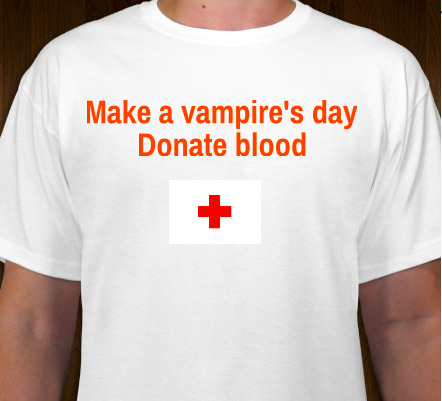
This shirt might violate the Geneva Convention. Unclear on the details.
You’d think, over time, these people would notice that all their blood gets stolen and, say, move their base of operations, or up security, but the hospital your vampire friend keeps stealing from has never done that. Maybe you live in an area where people just don’t care that much about blood theft.
Scenario 2 is more difficult. If you’ve donated blood before, you’ve probably noticed that the nurses don’t take all your blood. In general, they take half a liter. This isn’t chump change: the average human only has 4 to 6 liters of blood total in their body. You’ve got to wait eight weeks for your body to grow new blood before you can donate again.
How much do vamps eat?
To understand how feasible scenario 2 is, we need to know how much vampires eat. First, let’s establish that vampires are feast and fast predators. Unlike humans, they don’t need a relatively smooth consumption of calories (is that what vampires get from blood?) each day. Instead, they tend to eat some blood and then be fine for days or weeks afterwards.
If every vampire in the world was leaving behind a corpse drained of blood for human authorities to find and investigate every week, you’d think someone would’ve taken notice. Either that, or there aren’t that many vampires. Still, it seems safe to assume vamps are eating less than 6 liters a week, which means less than 1 liter a day (basically).
Indeed, it seems more realistic that non-ethical vamps probably only need maybe 5 liters a month, judging by victim production rates.
But, remember, vampires are incredibly wasteful when they drink. How many times have we seen a vampire lean down, bite a neck, and let the victim collapse, dead, some five seconds later? That person still has blood in them! Or, they let the victim’s blood drip all down their mouth and shirt. That’s food! Valuable food that you are wasting!

That's food!! Stop letting it drip everywhere!
So it seems more reasonable that vampires need maybe only 3 liters every thirty days, or 1 liter every decan (we still keep track of time in decans, right? That’s a thing normal people do?).
In consenting human terms, one human can give half a liter every 56 days, so you being the only source of blood for your (sort of) vampire boyfriend isn’t feasible unless you are some kind of blood-producing fiend. If we round that to half a liter every 6 decans, we need 12 regularly consenting human sources of blood to feed a single vampire (it took me longer to figure out how to do this math than I care to admit).
That looks tough, but remember, your (maybe) vampire boyfriend was already consuming the blood of 12 (not really) consenting humans every 60 days; the humans just didn’t know their blood was being eaten.
Conclusion
You so-called ethical vampire boyfriend is still killing people by stealing blood from the hospital. He’s just killing people that, before blood transfusions were invented, would’ve died of their injuries. This is not exculpatory unless you've got a very peculiar ethical system (which I do very much want to know more about).
If your friend wants to truly live up to his ethics, he needs to either steal blood not meant for donation (ignoring the nebulous cost to ‘science’) or find a minimum of 12 willing human donors who can provide for him on a rotating schedule.
I would also argue that, to be truly ethical, after one of his humans donates, he is obligated to give them a pack of Oreos and to not spam call them every eight weeks afterwards to ask if they still have blood.
blood donations near you
2 notes
·
View notes
Text
Can Your Character Survive... Altered Mental Status
Character E is confused. She thinks she's talking to someone besides Character F and accidentally admits that she has a crush on F while F is treating her injury. Oops.
Or, F is trying to get E out of the enemy base and E keeps laughing when F shushes her, attracting the attention of the guards
Whether for comedy or tension, altered mental status can add a fun wrinkle to your plot. But, what causes altered mental status and how do you make sure E survives?
STOPEATS
The big kahuna of the altered mental status world is the acronym STOPEATS. If it makes your brain go a bit wonky, it's probably included in STOPEATS.
Sugar
If E is a diabetic and lost track of her sugar intake, she could suffer from altered mental status as a part of hyperglycemia. If F knows E has diabetes, he can hopefully guess at the cause of her confusion and help her take her medication, or get her to a hospital.
Temperature
When the body gets really cold or really hot, the brain can stop working right. In fact, altered mental status is a key sign of being hypothermic vs. just cold. Ditto with heat stroke. Hopefully, the environment makes if obvious to F what is causing E's weird behavior. He can treat her by bringing her out of the cold or heat.
Oxygen
youtube
Hypoxia occurs when the brain is starved of oxygen, such as at a high altitude. It is most common in mountain climbers and pilots, such as the one in this video who reports having "no control" of his aircraft but otherwise, is not concerned at all about the situation. Astronomers may also suffer from hypoxia on occasion.

XKCD 1463: Altitude
Hypoxic people behave as if drunk. They are often euphoric, may speak slowly, and will act confused. The key treatment for high-altitude hypoxia is reducing altitude ASAP. In the video, you can hear the air traffic controller trying to coax the pilot lower. He knows he doesn't need the pilot to land—as soon as he can breathe a little better, he'll remember how to fly be able to land himself.
Pressure
If a brain injury causes bleeding in the skull, that blood has nowhere to go and can build up pressure. This causes the brain to lose functioning and is called intracranial pressure (ICP). It's the worst type of traumatic brain injury (TBI) besides one that just kills E outright.
If E is suffering from ICP, she'll probably be confused and behaving erratically. She may have gaps in her memory as well. Most likely, she'll also report "the worst headache of my life"—literally. In training, we were told to look out for that exact phrase when diagnosing head taumas. In later stages of ICP, E may also vomit, a lot.
Treatment involves getting to surgery ASAP so a doctor can cut open her skull and relieve some of the pressure. For obvious reasons, that is not something we attempt in the field.
Electricity
I'll be honest: I think they just wanted the acronym to work when they made this one E. What they actually mean in most cases is seizures. The classic seizure is a grand mal seizure, which involves the muscles tensing, twitching, etc. But seizures come in all shapes and sizes. For some, a seizure might mean smelling something that isn't there, or hearing music, or a single twitching muscle. Because seizures are unauthorized electrical activity in the brain, they can cause disorientation and erratic behavior.
Often, coming out of a seizure can be quite disorienting too. If F is helping E through a seizure, he should first try to prevent her from harming herself. If she's banging her head against the wall, that means putting a hand or pillow there. If she's near a table, that means moving the table. (NO sitting on / restraining people with seizures and NO putting stuff in their mouth! No! Why? You want them to choke? No!). As she recovers, F can remain calm, help her understand what happened if she needs it, and get her further care if requested.
Altitude
As with temperature, both very high and very low altitudes can cause brain problems (if you are beginning to suspect the brain is just a picky organ, you'd be correct). Scuba divers who ascend too quickly can suffer from nitrogen narcosis, which can lead to euphoria, confusion, memory loss, difficulty concentration, etc. (all classic signs of altered mental status).
If E goes too high, say, on a mountain, she could suffer from High-Altitude Cerebral Edema (HACE—controversial opinion but high-altitude stuff has all the good acronyms and names, HACE being but one example). It occurs when the brain swells at a high altitude and leads to confusion, lethargy, and a headache.
Luckily, as with most high-altitude problems, it can be solved quickly by going lower. When in doubt, on a mountain, taking the patient to a lower altitude is probably a good idea.
Toxins
Alcohol, LSD, marijuana, morphine—drugs cause altered mental status, as can bites or stings from venemous animals.
There are as many ways to treat toxins as there are toxins, maybe more, so I leave you with a fun fact the majority of snake bites in the US are people who tried to pick up the snakes.
In the words of Mod N's WFR instructor: "Red near black? Who cares. It's a snake. Why are you messing with snakes?"
Salt
Salt concentrations across cell membranes is one way nutrients travel into and out of cells. If E's blood suddenly has way less salt (electrolytes) than normal, this causes all the nutrients to flow out of her cells and into her blood, starving her organs. Brains run on salt and not having enough salt makes... neurons fire different? Stop firing? Something scientific and complicated. For our purposes: not enough salt = brain go weird.
This is called hyponatremia and is my favorite of all the STOPEATS ailments. Hyponatremic people behave as if drunk. The treatment is to 1) stop chugging water, 2) stop competing in your high-endurance sport (and therefore stop sweating), and 3) drink / eat something salty.
Conclusion
Give your characters altered mental statuses. It will be fun. I promise.
The most easily treatable problems that make brain go weird are: hypoxia and high-altitude cerebral edema.
Please write more characters with hyponatremia.
#ict#cycs#altered mental status#stopeats#writing advice#writing tips#hyponatremia#hypoxia#wilderness medicine
8 notes
·
View notes
Text
Common Misconceptions: Removing Impaled Objects
Uh oh. Character C is in the wilderness with Character D and they just got stabbed by a murderer / impaled by a tree branch / walked over barbed wire / fell on a pointy thing. What should D do? Leave the impaled object in? Or take it out?
Luckily, the author has read a lot of medical advice posts online and knows that you always leave impaled objects in. Right?
Nope. As a wilderness first responder, we are actually empowered to remove impaled objects in most cases (assuming we are two hours away from care).
Why Remove?
Leaving an impaled object in lets it do more damage. C is halfway down the Grand Canyon. One of those infamous Grand Canyon serial killers has just stabbed him. How does D intend to wrap the knife in place so that hiking out does not jostle it around and stab C more?
The answer is D cannot. The same is true of sticks and other implements—unlike in the front country, C and D need to travel at least two hours before care and that changes the rules.
A second excellent reason to remove an impaled object is if the object is so large, C cannot travel with it. In the wilderness, D might not have the ability to saw through a log so C and his impaled object can hike out together. Should D just leave C there? No! It's time to remove that impaled object.
A third excellent reason to remove an impaled object is when it is impeding a basic life support function. For instance, if C needed CPR and the barbed wire he'd impaled himself on was thwarting D's access, that barbed wire is gone. (Remember: when raising the dead, essentially nothing in contraindicated).
When NOT to Remove Impaled Objects
The object is in the eye
Eye liquid is difficult to replace. Losing it can mean losing the eye, so even though it sucks, D should leave the impaled object in C's eye while they hike out. D should splint the object in place using a cup or similar object and get out ASAP. Depending on terrain, D might also cover the uninjured eye. This is to keep C from moving his eyes.
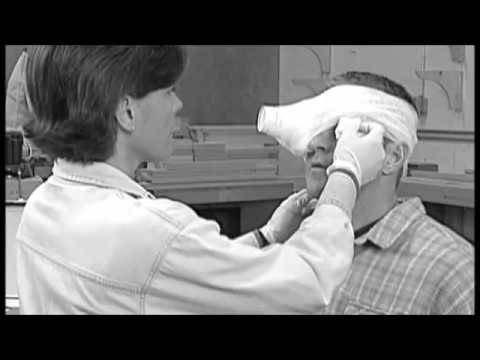
Put the cup upside down over the impaled object and wrap it in place.
The patient yells "stop stop stop!"
My WFR instructor liked to say "never say never, never say always," but one rule that is about as close to an always as you can get in the wilderness is: if the patient is screaming and begging for you to stop, you should stop.
Therefore, if D tries to pull out the impaled stick and C starts shrieking in pain, it is now time to leave that object in place.
Removing the object will cause more harm
If C was, for instance, impaled by a barbed harpoon, or shot with an arrowhead, it might behoove D to leave it in place during evacuation.
The same is true if it looks like removing the object will lead to blood loss, as blood loss should be avoided, in the wilderness and outside of it.
The impalement is in the core
The core is home to two of the three most important organs in the body, (and, unfortunately, to the spleen). It has also plenty of big arteries and other important things that should not be damaged. If evacuation is possible without removing the object, the object should stay in place.
Conclusion
The internet lied to you when it told you removing an impaled object was literally the worst thing in the entire world. Frontcountry, leave impalements in. Backcountry, we almost always remove extremity impalements.
#impaled objects#wilderness medicine#writing tips#writing advice#common misconceptions#ict#spleen hate
99 notes
·
View notes
Text
CYCS... Hypothermia?
Let's set the scene. It's cold. Outside the cabin, the wind howls. Character A has had a crush on Character B for as long as A can remember and what's this? B spent too long outside and has caught quite a chill? The only solution, surely, is to get in a sleeping bag and cuddle until B has warmed up. Hopefully, the treatment won't awaken anything in anyone... and hopefully, it will treat the hypothermia.
What is Hypothermia?
Hypothermia is when your body gets too cold. If you want to get all technical about it, it's when body temperature falls below 95 degrees F, but in the wilderness, we don't usually need a thermometer to reckon something is hypothermia and treat for it.
Types of Hypothermia
Acute hypothermia
Character A and B wanted to enjoy a nice (romantic?) skate on a frozen pond before retreating back to the cabin. Suddenly, the ice cracks (this is why we don't skate on frozen ponds). A leaps forward but it's too late—B has fallen through the ice into the freezing cold water below.
A conducts an excellent rescue, hauling B back onto ice and then onto dry land, but even being in the water for a few minutes has caused B's body temperature to plunge. She is now suffering from acute hypothermia, which is hypothermia caused by a sudden, large decrease in body temperature
Long-onset hypothermia
A and B opt for a cross-country skiing trip over the taiga. They're bundled up against the cold: hats, gloves, long underwear, snow pants, the whole nine yards, ten yards even. As time passes, B catches a bit of a chill, but it's nothing too bad. The team decides not to stop for lunch so they can get farther and by the time they return to the cabin, B is a shivering, babbling mess. She is suffering from long-onset hypothermia, which is hypothermia that occurs when someone is a little too cold for a little too long.
Unlike in acute hypothermia, by the time A starts to treat B, B's body has used up most of the resources it has to regulate temperature.
Symptoms of Hypothermia
Hypothermia can be roughly separated into three stages: mild, moderate, and severe. Everyone, I'm sure, will be surprised to hear that severe hypothermia is the worst. However, mild hypothermia isn't just "really cold." To count as mildly hypothermic, B needs to have an altered mental status.
Symptoms of mild hypothermia
A few obvious symptoms:
Shivering
Feeling cold
Reduced coordination
A few less obvious symptoms:
Nausea
Hunger
Confusion (gotta get that altered mental status)
Faster breathing
Symtoms of moderate hypothermia
Moderate hypothermia is my favorite stage because we break out the uncontrollable shivering. We've all shivered, I'm sure, but if you expend some effort, even if you are "really cold," you can stop shivering.
Not so in moderate hypothermia. B is literally incapable of not shivering anymore.
B is also suffering from all of the symptoms in mild hypothermia but worse now.
Severe hypothermia
Uh oh. Uh oh. B has... stopped shivering.
This is bad. The body is so cold, it can no longer compensate by vibrating really fast. This is when you get patients who remove all their clothes (called, to my delight, paradoxical undressing) even though they are dying of being too cold.
B is now extremely confused, probably not making much sense when she speaks, if she can speak at all. Her heart rate is weak—if A checks her pulse, she may not even have one anymore (but don't initiate CPR!). She's panting more than breathing.
If the hypothermia progresses untreated, she will slip into a coma and die.
Complicating factors
What can make hypothermia worse? All the usual stuff: being young, being old, being sick, having a head wound that exposes the brain to the elements (you know, just normal stuff).
Less intuitive, perhaps, is that burn patients are at a high risk of hypothermia. (Imagine how annoyed you'd be if you burned yourself [got too hot] and then simultaneously had hypothermia [got too cold]). But, burns are basically big open wounds on your skin. Skin helps regulate body temperature and keeps your warm (sort of like blanket?) and if it is injured, it struggles at the job.
In all but the most balmy environments, as soon as someone gets an extensive burn, the wilderness first responder is thinking about the increasd risk of hypothermia.
But enough about that. Let's get A and B into the same sleeping bag.
Treating Hypothermia: when do my characters get to cuddle??
Severe hypothermia cannot be treated in the field. When people who get super cold are rewarmed in hospitals, they suffer from myriad heart problems, including heart attacks and strokes. Unless you need a lot of angst in your story, refrain from giving your character severe hypothermia.

So, how to treat mild or moderate hypothermia? Two things are key: 1) human burrito, and 2) food, food, food.
Human burrito
B is too cold. What's warm? Blankets! One legit wilderness treatment for hypothermia is to essentially wrap B up in a ton of blankets.
A places B on a blanket or in a sleeping bag. She carefully puts hot water bottles on her neck, armpits, thighs, and ankles (or other places—if A doesn't remember where to put them, a hot water bottle basically anywhere won't hurt). A zips up the sleeping bag, then burritos B in the blanket until she is all snuggly and warm.
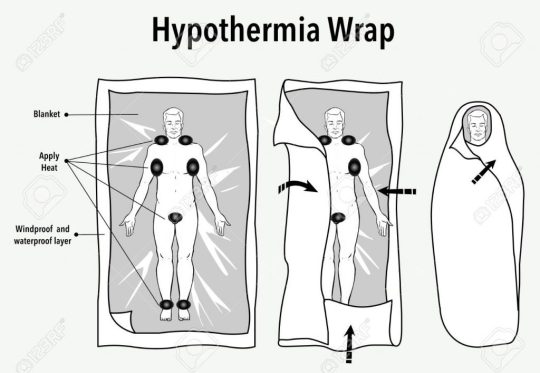
Source
No water bottles available? Uh oh. Guess A will just have to slide into the sleeping bag next to B to keep B cozy and warm. (Note: water bottle method is preferred becase 1) water bottles are warmer than people, and 2) it frees A up to move on to the next stage of treatment).

Food food food
A has just dragged B in out of the cold and diagnosed her with hypothermia. The only food they have in the cabin is ice cream in the freezer and a pot of water that she could boil to make tea. What should she feed B?
If you guessed hot tea, congrats on being incorrect. The best food to give to a hypothermic patient is whatever food you can give them immediately, in this case, ice cream.
Fun fact: in stage two of hypothermia, you burn 600 calories an hour from shivering (or an entire Snickers bar each hour). Replacing these calories is vital.
But, I hear you cry, ice cream is cold! Won't ingesting cold food make B colder? To which I reply, yeah, maybe, but it's all sugar and fat and you know what sugar and fat are good for? Shivering. B cannot ingest enough hot tea to warm herself up from hypothermia—she needs to shiver her way through this. This also means tea without sugar is essentially useless to treating hypothermia. If someone is really cold, all we care about are calories.
Conclusion
Hypothermia occurs when you are so cold, your brain stops working right.
During hypothermia, first patients shiver a lot and then they stop shivering and this is actually worse.
Treat hypothermia by wrapping the patient up in blankets and feeding them a lot of any type of food.
Yes, if you must, your characters can cuddle for warmth to treat hypothermia. Just make sure there's a lot of food within reach from the sleeping bag.
58 notes
·
View notes
Text
Can Your Character Survive... Avalanches?
Alternative title: why your character who lives in the mountains should be more scared of avalanches than they currently are.
What's an avalanche?
youtube
Avalanches are large masses of snow that speed down mountainsides, carrying humans with them. There are a number of different types of avalanches, depending on who you ask. Let's look at a few:
Wet Snow Avalanche
youtube
These avalanches are relatively safe, as far as avalanches go. They travel slower than their dry counterparts (10 to 20 miles per hour) and are harder to trigger. However, wet snow is often a good deal heavier than dry snow, so getting buried in it is still inadvisable.
Sluffs
youtube
Sluffs are dry avalanches composed of the top layer of powder moving downwards. They occur when the weak layer of snow is on top as opposed to underneath, and they are far less dangerous than the opposite, a slab avalanche.
Slab Avalanche
(Or, as I cannot help but say in my head every time I read about them: Slabalanches.)
youtube
A slab avalanche occurs when the weak layer of snow is on the bottom. When an avalanche is triggered, the weak layer separates from the slope and carries with it the stronger, more cohesive snow on top of it in a slab.
Slabs are typically about the size of a football field and more than a foot deep. They can reach speeds of 20 miles per hour within three seconds, 80 miles per hour within six seconds, and max speeds in excess of 150 miles per hour.
Hidden by more compact snow, the weak layer can lie in wait for days or months until something heavy (say, a human) triggers it loose. To make them even deadlier, the break often occurs above whatever triggers it, meaning the victim is already on the slab when it starts to speed down the slope.
How do avalanches kill you?
In the words of Shakespeare, let me count the ways. (spoiler: there are two).
Asphyxiation
In a study in Utah, 85% of avalanche fatalities died of asphyxiation alone. This is likely because humans cannot breathe snow [citation needed].
Once an avalanche gets going, the snow behaves sort of like water, and any humans trapped in it sink. However, unlike water, when the avalanche stops moving, it hardens, leaving the sunken human entombed in concrete-hard snow—this snow sometimes also hardens in the victim's lungs, with predictable consequences. It is essentially impossible for a fully buried human to dig themselves out of an avalanche—most victims won't even be able to move their limbs. It is now a race against time: can rescuers dig them out before they run out of air?
To make matters worse, human breath is hotter than snow. As the trapped human exhales, they melt a small pocket of snow around their face, which then refreezes as far-less-permeable ice. Any chance of breathing through the snow pack has now disappeared.
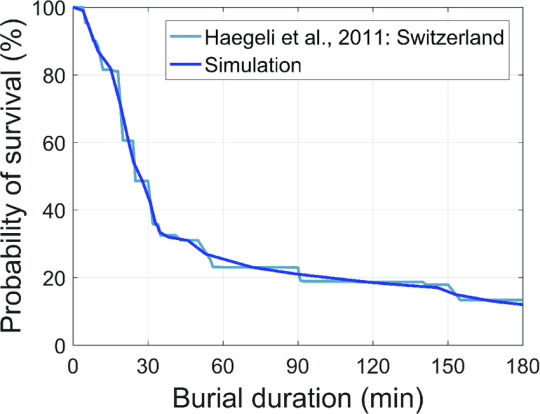
Source: A concept for optimizing avalanche rescue strategies using a Monte Carlo simulation. (And you know a paper is good when they're whipping out the Monte Carlo simulations).
After only about 20 minutes, a buried victim has less than a 50% chance of survival. Avalanche rescues are all about time time time. But I'm getting ahead of myself.
Blunt force trauma
In the remaining 15% of cases, that same Utah study found that blunt force trauma was involved in the death. This hopefully makes sense, given how fast, heavy, and large avalanches are.
In some terrains, avalanches can take helpless victims through a "sieve." Let's say you had to be dragged down a slope at 150 miles per hour. In the picture below, which slope would you prefer: A? Or B?

Hopefully, you said B. While being dragged anywhere at high speeds is undesirable, at least B is empty. A is a sieve, and anyone swept through those trees would be lucky not to hit at least a couple of them.
Avalanche Likelihood
According to Bruce Temper's Staying Alive in Avalanche Terrain, 9 out of 10 avalanche victims trigger the avalanche that kills them. That means your character has a lot to do with whether or not they die.
Since we are are all authors here, let's design the scenario most likely to kill a character.
Avalanche-friendly conditions
There has been a recent, dramatic change in weather (storm to no storm, hot to cold, cold to hot, etc.).
The slope is between 30 and 45 degrees steep (contrary to popular belief, steeper does not automatically make an avalanche more likely). Side note: humans are rubbish at judging slope, so a modern-day experienced backcountry explorer will likely have her clinometer on her.
The slope faces north. These slopes get less sunlight in the winter (in the Northern Hemisphere), which makes the slow less 'sticky' and more unstable.
The slope is wind-loaded or beneath a cornice. If a cornice falls, it can trigger an avalanche above you, which is the worst place for an avalanche to be.
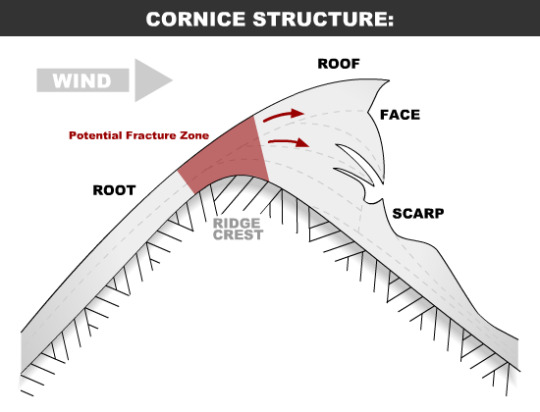
It has recently snowed (or is currently snowing!).
It's been windy recently.
Risky character traits
Your character doesn't know the area well.
Your character is a man (assuming the story takes place on Earth, where 92% of avalanche fatalities are men).
Your character is in a group that wants to press forwards.
Your character is overcommitted—they need to get to their destination, fast.
They are convinced they are an expert, or that someone in their group is.
Other people have gone down that slope already, which makes your character sloppy. Unfortunately, avalanches don't always trigger when the first person touches them.
Ironically, a slope that no one has gone down is also dangerous due to "powder fever," or the delight some skiers feel when they see an untouched slope and stop doing risk assessments.
High consequence locales
In the sections above, I discussed risk, or the likelihood that a bad thing (avalanche) occurs. Potential consequences also matter—it is safer to engage in high risk activities in places where the consequences are low, like rock climbing without ropes one foot off the ground.

How to make your avalanche as high consequence as possible?
Your character is alone. Recall that at 2 hours, the likelihood of surviving an avalanche has fallen to 20%. If your character is alone, what is the chance anyone notices they're missing within 2 hours, let alone they get to the exact slope where they're buried in that time?
The landscape has a lot of rocks or trees, making blunt force trauma likely.
The bottom of the slope is a crevasse or river bed or narrows as it goes down. This is because it takes time to dig someone out of an avalanche, even after you find them, so the deeper your character is buried, the more likely they are to die.
Avalanche Rescue
The worst has happened: one of your characters has been swept away in an avalanche and buried. Now what?
If we want a 50% chance of survival we have 20 minutes to 1) find the victim and 2) dig them out.
Immediately, your character's friends, who are, of course, avalanche rescue experts, leap into action. Having determined the slope is safe, they get to wherever the avalanche ended as fast as possible and commence a search.
Before launching into a search pattern, bystanders probe areas there friend has a high likelihood of being in. This means probing around any equipment they see sticking out of the snow (ski, glove, hat, etc.) and especially around any limbs (if the buried person is sticking a hand above ground and waving, start there). They also check around protruding objects like rocks, where their friend may have gotten stuck.

Source.
Probing means sticking a ski pole or some other long object into the ground at a 90 degree angle in the hopes that you poke the buried person.
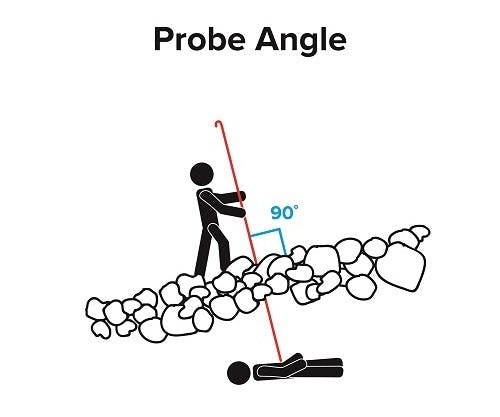
Source. *poke* "Ouch!"
A note on pole length: six feet should be adequate. It is both rare to be buried deeper than six feet and essentially impossible to rescue someone six feet under before they die.
Let's say your characters probe all the likely areas and find nothing. Now what?
Beacon search
What is an avalanche beacon? Basically, beacons are small devices you can carry into avalanche country that help you find your friend, or your friends find you, if one of you gets caught.
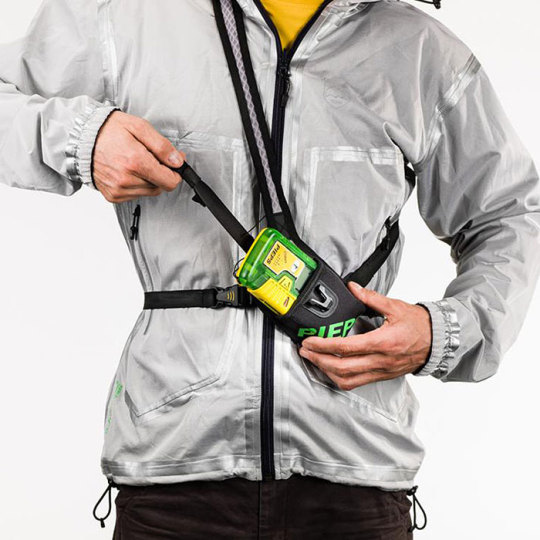
Example of an avalanche beacon. Source.
Avalanche beacons have two modes: "send," which sends out a signal, and "search," which looks for a signal. The idea is, everyone on your team has what is essentially a GPS tracker on them. If one gets buried, the others can use their beacons to triangulate the position fast enough to, hopefully, do a fine search in the correct area before the buried person is dead.
If the bystanders in your plot have beacons, they switch them to "search" mode. (It is tragically common for people who carry beacons, but don't practice with them often, to commence an excellent search pattern while their beacons are still projecting their location instead of searching for the location of their friend.)
youtube
The video above shows an example of a search pattern with one rescuer. The more rescuers, the faster the search, and the more likely the buried victim is to survive. The picture below shows some multi-rescuer search patterns.

Search patterns based on the number of searchers. Source.
Beacon-less search
What if your characters don't have beacons? First of all, they had better be in a world without beacons, because there isn't really a good excuse to be caught in an avalanche without one. Even if you are skiing alone, because beacons are interoperable, you might as well carry one to help out any potential rescuers.
But let's say your character lives in pre-industrial avalanche country so we can't judge their decisions too hard. Now what?
Assuming the victim's hand isn't sticking out of the ground and waving for help, your rescuers are stuck doing a probe search everywhere. This involves sticking a long pole in the ground every 1.5 feet or so in a spiral or grid pattern and hoping you poke your friend before they die.

Source
A spiral search may be easier with only one rescuer.
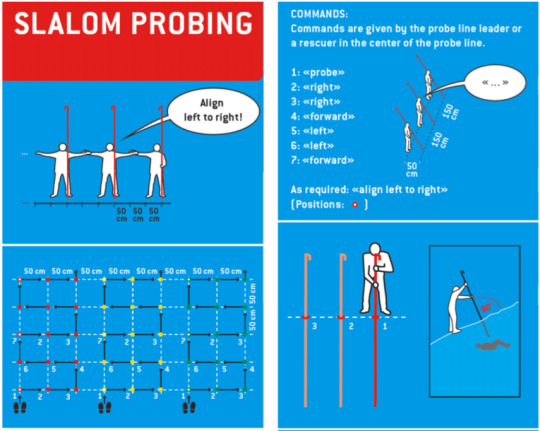
Source
If there are a ton of bystanders ready to rescue the buried victim, they can get regimented about it, setting up lines and moving in interlocking grid patterns to search the largest area possible in the shortest amount of time.
DIG
The rescuers have successfully poked the buried victim. The next step is simple: DIG.
https://www.youtube.com/watch?v=hJbnc4MjylI (no more embedded videos allowed :sad face:)
https://www.youtube.com/watch?v=dGQg9o3vAkM
Medical Care
Ideally, your bystanders dig the head out first, since this is the body part with all the important bits in it. My WFR instructor recommended starting Positive Pressure Ventilation (PPV—the thing you see in movies with the plastic mask and bag that EMTs squeeze to help someone breathe) immediately after rescue unless the victim protests loudly. This can clear snow out of the lungs and in general help them maintain oxygenation.
As other body parts get uncovered, treat what you see.
How to Show Your Character is a Pro
They dig a trench before going out too far. This allows you to see the layers of snow and judge how likely an avalanche is.
https://www.youtube.com/watch?v=vcXogVHecFQ
They test snow density by trying to poke through it with a knee, hand, finger, and knife.
They might also intentionally knock a cornice over to see if it triggers an avalanche (this is done from a safe distance).
And finally, they consider walking above someone on a dangerous slope attempted murder.
Conclusion
The best way to survive an avalanche is to avoid being caught in one. Barring that...
We at ICT recommend your character carry a beacon, be in relatively safe territory, and have a flock of friends available for rescue purposes.
29 notes
·
View notes
Text
Can your character survive... broken bones

Broken bones: truly, the simplest injury to give your character. You don't need a medical license to understand what the problem is and it doesn't sound too serious.
In the backcountry, though, everything has potential to become serious. Let's say your character is in a desert waste, or a snowy tundra, or the middle of the ocean on a boat. How much should your character worry about a particular broken bone?
Not Super Concerning (we're in the wilderness, so we should be worred, but not excessively)
This injury needs to 1) not be life threatening in and of itself and 2) not prevent them from doing any life-sustaining activities. A broken ankle to a character whose only mode of transportation is a kayak is not particularly serious. (ModN, professional-kayaker, here to comment: definitely not true.) If your chatacter breaks that same ankle halfway up K2, now we're a bit more worried.
So, what can you break that's probably not a huge deal?
Fingers, assuming the character can still use most parts of their hands.
A rib (but not more than one), assuming no lungs are punctured.
A tooth.
A metacarpal (the finger bone that is in your hand) or a wrist bone, again, assuming this isn't preventing the character from foraging for food or something.
Nose. Eh. It's probably fine. As long as you don't inhale blood; that is inadvisable.
Toe—having broken many a toe, you can pretty much still walk, it just sucks.
Ankle or metatarsal, assuming the character doesn't need to walk, or can splint it well enough to walk on it.
Kind of Concerning
Now your character is probably going to need a little help, have nerves of steel, or have some medical knowledge to get through this (again, assuming we're in the wilderness). We're talking broken arms, broken lower legs, multiple broken ribs, maybe a collar bone or shoulder or kneecap.
And we're specifically talking stable fractures.
Stable Fractures
Stable fractures are, essentially, fractures that are Not As Bad As They Could Have Been. A character with a stable ankle fracture might notice:
"Hey, I can still mostly walk on this" and "this joint is still basically the shape that I would expect such a joint to be" and "this fracture feels stable." With a little medical training, they might also notice: "I still have a pulse downstream from this fracture" (in this case, in the foot) and "I'm not experiencing (much) numbness and tingling."
We can treat stable fractures with RICE: Rest, Ice, Compression, and Elevation (ModN: less so now – this is falling out of favor with the medical establishment). Your character would probably benefit from a splint or brace, especially if they need to remain mobile and a below-the-pelvis bone is broken. So long as the break still feels relatively stable, they can continue most activities (like, don't kick things with the broken foot, but if you can walk okay, that's fine).
Exceedingly Concerning
These are fractures that pretty much require help or your character isn't going to make it. They can be life threatening in and of themselves or so debilitating that a character will starve to death or succumb to exposure before they can heal.
Let's sort them into three categories: unstable fractures, fractured Important Bones, and compound fractures.
Unstable Fractures
An unstable fracture is a worse fracture, as far as these things go. A character with an unstable fracture might notice the following: "I can't put weight on this fracture or operate the limb anymore," "I've lost feeling or a pulse below the fracture," "This limb/joint isn't the right shape anymore," "This feels unstable," or "ow ow ow ow ow ow ow ow ow."
Let's talk a bit more about that pulse. In the WFR business, we talk about CSMs (PMS if you're an EMT because... they wanted a really bad acronym, I guess [ModN: can attest]). That stands for circulation (pulse), sensation, and motion/movement. These three tend to be connected because blood vessels, and nerves travel side by side in neurovascular bundles. If an injury cuts one off, the others are probably going to suffer soon.
A patient with all three CSMs is in better shape than one without. Why? Because limbs need blood to get oxygen (oxygenation and perfusion anyone?). They also need nerves to feel things. And it's nice when they are able to move intentionally. If an injury cuts off any CSM for too long, you risk losing the limb, or damaging it permanantly.
Another problem with missing C in particular is that is could indicate internal bleeding, which is in itself a life threat.
So, unstable fractures:
Are bad
Could lead to volume shock (bleeding out internally or externally)
Prevent your character from doing life-sustaining activities
Hurt a lot
Treating Unstable Fractures
First, we TIP (traction in place). Essentially, your character's friend (who I'm assuming they have with them, since we want them to survive) is going to gently pull that limb back into place. If you don't know what "back into place" means, just think: "what is this limb supposed to look like?" That the proper place. You can google some pictures of unstable fractures if you need more assistance in that area. You should do this using traction – don't shove the false joint back into place. Instead, gently tug on the end of the affected limb to allow things to realign themselves.
You should TIP slowly and carefully. If CSMs become worse with movement, stop. If your patients yells "ow ow ow stop stop stop," stop (this is also just a good tip for life in general). Also, don't traction a spine unless you really know what you're doing.
If TIP works, the limb should now look more like a regular limb. Even if it didn't, the next step is still a splint. A splint for an unstable fracture just needs to keep the limb in place and ideally prevent further injury during evacuation. There are so many ways to DIY a splint, we're probably going to do a post on it eventually (and then I'll forget to link it here, so that's not super helpful for you to know but I thought I'd mention it).
To be clear, a TIPed and splinted unstable fracture is still bad. It's life threatening. It requires more care. But maybe it is not in the way as much anymore, which is good.
Important Bones
Not all bones are made equal. There are four bones you should not break, not in the frontcountry and certainly not in the wilderness, and they are: the femur (big thigh bone), the pelvis (hip), the spine (ModN points out this is more than one bone. ModN is no fun), and the skull.
The femur and pelvis are bad to break for two reasons. First, you can't walk if they're broken. (Wanda Rutkiewicz, who attempted to climb K2 with a broken femur, is an outlier and should not be counted—she also is the first woman to summit K2, so I guess it paid off in her case). Second, these bones are close to a lot of big and important arteries. Broken bones generally have sharp bits, which can be like knives inside the body (or outside the body, if they are compound fractures). Knives + artery = :(.
The spine is bad to break because the spinal cord carries messages from brain to body, including the message to, you know, keep breathing. A broken neck with severed spinal cord can just kill you by asphyxiation. Even if the break is lower down, not being able to walk in the backcountry is bad (except for our brave character whose only mode of transportation is a kayak—they're doing great [ModN: ummmmmmmmmmm]). Also, spine breaks can have a heavy psychological toll. A halfway decent way to assess if someone's spine is broken is if they tell you, "Something is really wrong with my spine. It feels really bad and I am panicking about." People who break their spine often report that they could just tell something was really wrong. Panic isn't that bad when compared to bleeding out and dying, but it doesn't exactly make things easier, does it?
Breaking a skull is bad because the brain lives in there. Remember, there are three important organs: lungs, heart, brain (and definitely not the spleen). But really, there's only one important organ: brain. If things can access the brain from the outside, this is bad. It's also bad if bits of skull stab the brain.
Treating Fractured Important Bones
Urgent evacuation. Barring that...
Femur and Pelvis
You can splint the femur or pelvis. The goal of a femur splint is to make the femur not move. That means we're probably going to use a buddy splint. Anything that can tie the broken leg to the good leg without causing pain or loss of blood is fine in this situation.
(How is my character going to get around if their legs are tied together? They are not—their femur is broken).
A note for if you're googling around for femur splints: you're probably going to find a traction splint. From what I understand, especially in the wilderness, the science on that is somewhat up in the air. If your patient expresses a traction splint makes the injury hurt less, and it doesn't compromise CSMs, it's probably fine. If it hurts more, do not force someone into a traction splint just because google told you to.
We can think of the pelvis sort of like a book. When it breaks, that's sort of like the book falling open. The goal of the splint is to gently tie the book shut.
youtube
This video shows an improvised pelvis splint. Your character can do this with anything long, wide, and soft. Note how the end result is pressure from the sides, holding the pelvis together.
Also note, in real life, your character would probably be screaming incoherently as this happened. Pelvis fractures hurt, and this is an exception to the "if your patient screams ow ow ow you should stop" rule. This splint is going to hurt, and it's still better than the alternatives, which mostly involve dying.
Now that the patient is all splinted up, can we get to that urgent evac?
Spine
If there's such a thing as a spine splint, I haven't heard of it. You can use a backboard or vacuum mattress, but to be clear, that fully immobilizes your character. The danger with a spine fracture is that the sharp ends of broken bones can cut the spinal cord, which is where all the orders from the brain go to reach parts of the body. That means, to avoid paralysis, we'd like to avoid jostling and jiggling.
A word of optimism: it's actually possible to survive a broken spine on your own, even in terrible conditions. I've spent ten minutes now furiously googling which book this was (I've read many about mountain climbing) and cannot for the life of my find it, so I'll give you the summary and come back and link the book if I ever remember.
After a nasty fall on Denali, the tallest mountain in North America and one of the most dangerous in the world, a climber broke his neck (the bone, not the cord). He managed to crawl down to base camp, even though he couldn't sit up or lie down without cupping his head in both hands to keep it from jostling his neck and potentially severing the cord.
In fact, there is some evidence that spine injured patients are better than responders at knowing how to move to avoid hurting themselves more. When victims of car crashes are allowed to walk from the car and lay down on the stretcher, they are less likely to damage their spines than if they are manhandled out of the car by responders attempting to protect their spine.
In general, a character who knows their spine is hurt will want to focus on keeping their spine in alignment. If that means walking upright or lying down flat, they should do that. In the case of the man with the broken neck, that meant crawling, since it was easier to keep his neck in alignment. They should avoid any pulling motions, like someone dragging them by the head (everyone should avoid this in all cases, pretty much) and twisting motions, like trying to crack their back (don't try to crack your back if your spine is broken).
So, it is not unreasonable for your character with a broken spine to survive in the wilderness alone, assuming they're lucky and have experience. Otherwise, if you want them to live, why not give them a friend or two to help them get back to the frontcountry?
Skull
Assuming we can't evacuate right now, we're going to prevent anything from going into the brain and treat for shock (give fluids and food, monitor, and stop any bleeding). Another thing to consider is hypothermia: the brain can lose a lot of heat if it's exposed (this is a very bad injury), so keep your character warm.
Also, they're probably going to die. I do not personally recommend this injury for characters who still have plot relevant things to do.
Compound Fractures
Compound fractures, or open fractures, are any fracture that involves breaking skin. Note, this includes small breaks in skin where you can't see the bone, or breaks where you think the wound might've been caused by something other than the bone breaking but aren't sure. (For example, if you stub your toe really hard on an annoyingly sharp doorframe, breaking a bone and incidentally scraping your toe elsewhere, you've got an open fracture, and it warrants a great deal of care. ModN got lucky on that one.)
Compound fractures are bad, even in small bones (like fingers) because they:
Can lead to volume shock
Can get infected! In particular, bone infections are Very Bad
Render the limb mostly unusable
Look gnarly af
Since we're all writers here, I assume we can imagine just how viscerally uncomfortable it would be to see your bone (an inside bit) sticking out of your skin, so I will not belabor that last point. (ModN: this I can attest – we had some impressive moulage/stage makeup for an open tibia fracture during a practice scenario, and even knowing it was fake it was deeply unnerving.)
Treating Compound Fractions
Assuming the patient isn't bleeding out, in which case we treat that first, we handle compound fractures similarly to other fractures with one crucial first step: wound cleaning.
Before we TIP or splint, we are going to clean that wound. This is because TIPing will likely involve putting the bit of bone on the outside back into the inside. If it got infected in its brief stay in the outerworld, we don't want to shove those bacteria directly into the blood stream.
After cleaning, check CSMs and TIP (unless your patient begs you to stop or you really need to yank it hard to get it to move) and splint in place. Also, evacuate. Urgently.
Conclusion
For minor inconveniences that could turn bad, we at ICT recommend breaking:
Finger
Toe
If you don't want to lose limb functionality but want the character nerfed for a bit, may I recommend:
Ankle
One (1) rib
Minor wrist bone
If you want someone to have to care for this character for a while but not have the threat of death constantly on the horizon, check out:
Broken lower leg (rendering character mostly immobile)
Broken collar bone (rendering arm immobile)
Fractured femur (in a safe environment, with helper who has some medical experience, and with a lot of angst)
Broken vertebra with severed or unsevered spinal thoracic or lumbar cord (you're going to have to play a little fast and loose with the facts on this one, but the care / comfort aspect is there)
If you want this character to be in a fight for their life, why not sprinkle in:
Compound fracture, possibly with arterial bleed or secondary infection
Unstable fracture, especially of the femur or pelvis
Spinal fracture without spinal cord damage
If you want your character to (probably) die, take a gander at:
Broken skull
Broken spine with severed spinal cord
Compound femur or pelvis fracture
And if you want to go from serious to not serious real quick, try:
First Responder finds Patient and discovers they have no feeling or movement in their legs or feet. Oh no!
First Responder panics, thinking Patient is newly paralyzed halfway down the ski slope
First Responder remembers training and asks for a SAMPLE history
Patient reveals that the spine was already broken and if there's no other injury, they're fine to ski down (First Responder probably should've noticed the monoski, but whatever; they were freaking out.)
First Responder feels a little dumb, but also glad that Patient is fine
18 notes
·
View notes